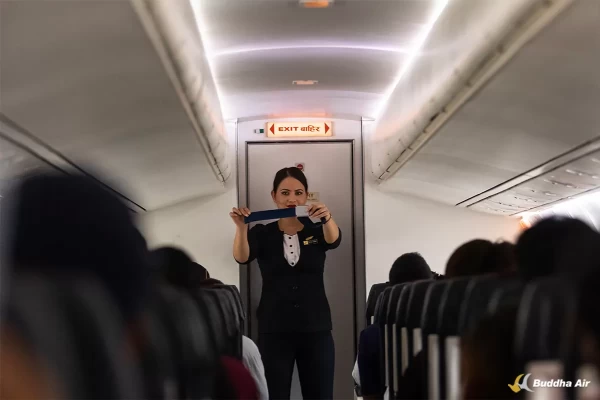Essential Aircraft Safety Equipment to Stay Safe in the Air

Every aircraft is carefully designed and fitted with built-in as well as add-on safety equipment, all responsible for keeping us safe. These are tools and systems that overlook the safety and well-being of passengers and crew during routine flights and emergencies. Whether it’s protecting passengers during turbulence or providing life-saving measures during an evacuation, safety equipment on aircraft forms the backbone of aviation safety.
What is Safety Equipment in an Aircraft?
Aircraft safety equipment refers to all the tools, systems, and devices installed or carried onboard to support the aircraft’s operations, safety, and comfort. These items include everything from navigation tools to emergency systems and passenger comfort features while ensuring that the crew can respond effectively to unforeseen situations.
Equipment on aircraft can be broadly categorized into operational equipment, passenger convenience items, and safety systems. For example, operational equipment includes aircraft navigation systems and cockpit instruments, while safety systems include fire extinguishers, oxygen masks, and life vests. Additionally, the aviation ground support equipment list encompasses tools and machinery used during pre-flight checks and maintenance, further ensuring flight safety.
You may also read: Guide to Aircraft Inspections to Ensure Flight Safety
List of Aircraft Safety Equipments
1. Oxygen Systems
One of the most significant parts of safety equipment on aircraft, oxygen masks are designed to provide supplemental oxygen to passengers and crew in the event of cabin depressurization. These masks automatically deploy when the cabin pressure drops below safe levels, ensuring everyone onboard has access to breathable air.
2. Fire Extinguishers
Aircraft are equipped with multiple fire extinguishers to handle fires in the cabin, cargo hold, and engine compartments. This piece of ground handling equipment for aircraft is strategically placed to ensure easy access during emergencies.
3. Seatbelts
As a passenger, you must always put your Seatbelts on as long as the cabin crew advises you to do so. Seatbelts are part of the basic equipment on aircraft and maintain safety during turbulence or other unforeseen circumstances.
4. Emergency Lighting Systems
Emergency lighting systems guide passengers to exits during evacuations. These lights illuminate the aisles and highlight exit doors, making it easier for passengers to navigate in low-visibility conditions.
5. Evacuation Slides
Evacuation slides are inflatable devices that allow passengers to quickly and safely exit the aircraft during emergencies. These slides are mandatory on all commercial aircraft and are an essential part of the list of equipment on aircraft for safety.
Also read: Emergency Exit Doors: Everything You Need to Know
6. First Aid Kits
First aid kits onboard cater to minor medical emergencies. Additionally, aircraft are often equipped with advanced medical kits containing items like defibrillators to handle more serious conditions.
List of Other Equipment on Aircraft
While safety equipment is a priority, aircraft also carry various other tools and systems for operational and passenger needs. These include:
-
Cockpit Instruments: Tools such as altimeters, airspeed indicators, and navigation systems fall under types of equipment on aircraft that support safe and efficient operations.
-
Passenger Comfort Items: This category includes in-flight entertainment systems, lavatories etc., which enhance your experience as a passenger.
-
Cargo Handling Systems: Aircraft often include equipment to safely secure and transport cargo, which is a vital part of aviation logistics.
-
Ground Support Tools: Items from the aviation ground support equipment list, such as tow bars, refuelling machines, and power units, play a crucial role in preparing the aircraft for flight.
-
Special Assistance: Buddha Ait also provides special assistance for passengers in need; like wheelchair services with passengers with a disability, support devices for elderly passengers, and stretcher services for passengers with severe medical needs.
You may also like: Special Assistance - Making Air Travel Accessible for Everyone
Conclusion
As a passenger, it is recurring to understand all safety equipment on aircraft and the broader list of equipment on aircraft to have confidence, trust, and an enjoyable flight. There are many reasons why air travel is the safest medium of transportation, and extensive safety precautions and preparation play a major role in this fact. From basic equipment on aircraft to specialized tools included in the aviation ground support equipment list, each component well-thought-out and designed to make each flight the safest it can be.
FAQs about Aircraft Safety Equipments
1. What are the Types of Equipment on Aircraft?
The types of equipment on aircraft can be broadly categorized into operational tools (e.g., navigation systems), safety equipment (e.g., oxygen masks, fire extinguishers), and passenger amenities (e.g., entertainment systems).
2. What is the Aircraft Equipment List?
The aircraft equipment list is a comprehensive inventory of all required tools, systems, and devices installed on the aircraft to ensure compliance with aviation regulations. It includes safety equipment, operational tools, and optional features.
3. What are the 7 Major Components of Aircraft?
The seven major components of an aircraft include:
-
Fuselage
-
Wings
-
Empennage (tail assembly)
-
Landing gear
-
Powerplant (engines)
-
Cockpit
-
Safety systems, which include safety equipment on aircraft like oxygen masks and life vests.
4. What is Aircraft Role Equipment?
Aircraft role equipment refers to tools and systems tailored to the specific function or mission of the aircraft. For example, firefighting aircraft are equipped with water tanks, while medical evacuation planes carry advanced medical kits.
